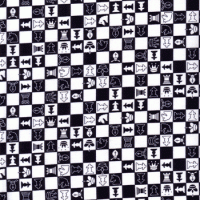I would like to thank all my readers for their comments. This feedback helps me to determine what would be the most interesting subject for my coming articles. Today I would like to answer some of your questions and requests. Due to the space limitations I cannot answer all of them of course and some of them are outside of the scope of my weekly column (remember, this is " Tactics from Move One!" and therefore we don't discuss much positional stuff here. Maybe one day if we start a sister column " Strategy from Move One!" :)
One of the readers asked about more advanced examples of the patterns we discussed. The one, where due to the obvious tactical threat coming from the pattern, our poor opponent has to make big concessions and therefore the pattern brings its dividends even though it didn't work the way we intended it to work. This is a very good question, and I am happy to present the next game. (I hope you get used to the fact that in my columns it is always quiz time :)
The next game (which was played in the next round of the same tournament !) features the same idea but White finishes his attack differently.
In one of the comments to my previous column I was asked why in all the games with the Bxh7 sac the French defense was played. Well, there is nothing wrong with the French defense and as you could just see, the Bxh7 sac can occur practically in any opening (well, unless your opponent played g6 and fianchettoed his Bishop as it happens in the King's Indian defense for example). But due to the fact that White has his pawn on e5 in most of the variations of the French defense, which drives away the Nf6 which is the best defender of the h7 pawn... well, you get the picture. So, if you play the Black side of the French, you should definitely be aware of the Bxh7 sacrifice.
Another reader asked me about an attacking pattern for the games started with 1.d4. Well, we just saw two of them, but let's talk more about this question in general. The patterns I show you are intended as a starting point for your creativity. You can borrow these ideas and reuse them in many different situations. So, it doesn't matter what opening you play, if you know a big number of typical patterns, you'll always be able to find one that could be useful in the position you have. Let me give you an example. In Part Two we discussed the pattern where White has Bb2, Ne5, pawn f4, Rook lift (Rf3-h3) and the Queen's jump to h5. What if one or more of the parts of the pattern are missing? You can still use the attacking set up as the next game shows. (I recommend you to deeply analyze every single move White played in this game, since the way he conducted his attack is extremely instructive!)
So, what have we learned today?
First of all, the typical patterns don't belong to any particular opening. If you know the ideas very well, you'll always find a way to reuse them in your games.
Secondly, sometimes with the help of a tactical pattern you only threaten to tactically annihilate your opponent, but in fact you are totally satisfied with the positional concessions he has to make in order to avoid the immediate tactical threat. And the last important point, you could notice that all three games we analyzed today were played in the same tournament which was played more than 100 years ago. For many youngsters chess starts from Kasparov. Of course they saw some games played by Fischer and might even have heard about Euwe or some other World Champions before WWII time, but that's about it. As you could see today, we still can learn a lot from the great masters of the past. So, I strongly recommend to analyze their games, notice the ideas they used and try to implement these ideas in your own games.
Good luck!







